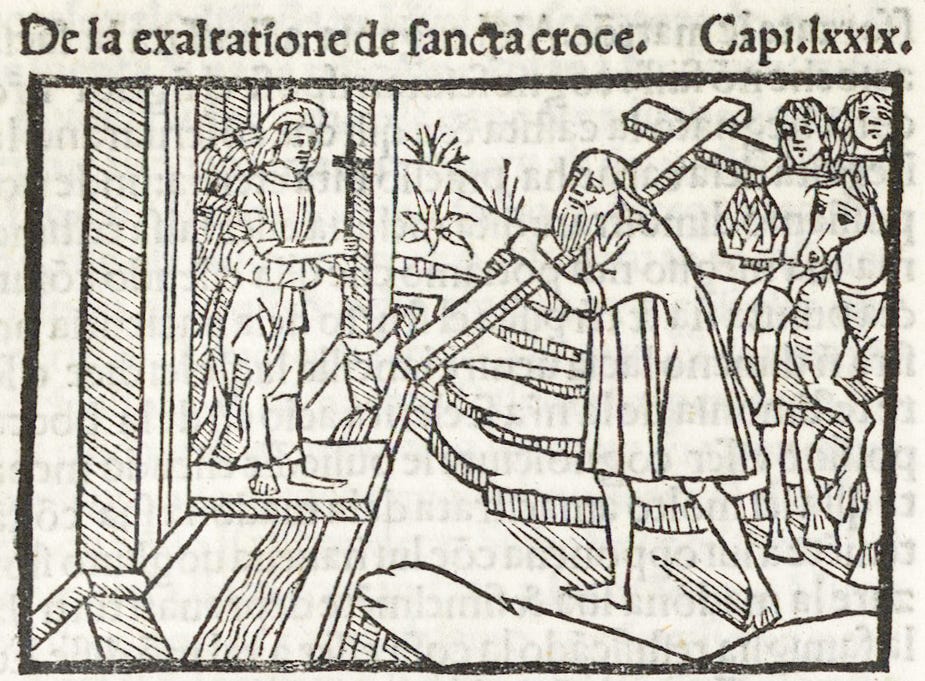The Exaltation of the Cross
Gospel Reflection for September 14, 2025 - John 3:13-17
And no man hath ascended into heaven, but he that descended from heaven, the Son of man who is in heaven.
And as Moses lifted up the serpent in the desert, so must the Son of man be lifted up:
That whosoever believeth in him, may not perish; but may have life everlasting.
For God so loved the world, as to give his only begotten Son; that whosoever believeth in him, may not perish, but may have life everlasting.
For God sent not his Son into the world, to judge the world, but that the world may be saved by him. (John 3:13-17 DRA)
Today we celebrate the Feast of the Exaltation of the Holy Cross. Traditionally, in English-speaking countries, this feast was known as Roodmas, ‘rood’ being an Old English word for Cross as in the rood screens once used in Latin churches in a way analogous to the iconostasis screens in Eastern churches. Additionally, prior to John XXIII’s radical deconstruction of the calendar, for over a millennium this feast on September 14th was celebrated specifically to honor the recovery of the True Cross from Jerusalem by Byzantine emperor Heraclius in the seventh century, after it was lost during the conquest of Jerusalem by the Sassanid Persian Empire. Providentially, this event occurred just before the rise of Islam.
The other event related to the True Cross, its discovery by St. Helena and its distribution as relics across the Roman Empire by Constantine, as well as his establishment of churches at the Holy Sepulchre (Martyrium) and Mount Calvary, in the fourth century, came to be celebrated on May 3rd, according to the Gallican rite’s traditional feast day. John XXIII eliminated this distinction and simply combined both events into the September 14th day, though some regions, such as the Philippines, retain the May 3rd tradition too. For this reflection, I would like to focus on the traditional event associated with today.
As Emperor Heraclius neared the Persian capital with his army in 628 AD, the Persian king fled, and his son, who was mortally ill, offered the True Cross to Heraclius, if the emperor would protect his infant son, and the emperor agreed. Heraclius then toured the Byzantine Empire with the recovered relic, famously displaying it in the Hagia Sophia in Constantinople. For this great work of Christian heroism, the emperor ironically became more famous in the Latin West than in the East, being named the ‘first crusader’ and included in the 13th-century compendium of hagiography, the Golden Legend. One account says that, upon returning the True Cross to Jerusalem, the emperor insisted on carrying it himself, against the advice of the patriarch. But finding that it was too heavy while riding his horse, he dismounted – and removed his crown. It then became miraculously light. Once he integrally submitted his earthly authority to Christ the King, the emperor was able to participate in Christ’s redemptive sacrifice.
Besides the Eucharist, the True Cross is the holiest remnant of Christ’s bodily presence on Earth, one which, as St. Thomas Aquinas poignantly wrote, is so soaked with His Blood and associated with His image that it can be adored (with relative latria), as we do in the Mass of Good Friday, unlike any of the other instruments of His Passion. With little dispute it may be said that the Cross is the most well-known symbol in human history – but not always in a good way. For non-Christians, it is, quite logically, associated with injustice, brutality and tragedy, committed by humans and permitted by God, a true “sign which shall be contradicted”, as St. Simeon said. (Lk 2:34) Indeed, in the Old Testament crucifixion is considered to be a curse: “for he is accursed of God that hangeth on a tree.” (Dt 21:23)
But this paradox, or what Dr. Anthony Esolen calls an ‘irony of faith,’ is precisely God’s intention. As we heard in the Epistle, By His very weakness, helplessness and ignominy, God is omnipotent, victorious and renowned. By taking on sin, He overcame sin; by dying, He defeated death; by allowing Himself to suffer every bodily affliction and every insult, He became utterly invincible – not merely in His Godhead, which never lost any of its divinity, but in His very humanity. By so accomplishing our redemption in the form of man, He elevated human nature into total communion with God, divinizing us by conformity to Himself. He thus made it possible, as He once taught holy Job, for us to answer the problem of evil with the redemptive suffering of the Cross, so that now, if accepted with a humble and contrite heart and offered up to Christ, worldly afflictions are the most powerful sign of triumph.
This is why we celebrate the Exaltation of the Holy Cross today, why all churches (should) have a crucifix firmly attached to every altar and why we wear crosses, hang them on the walls of our homes and make the Sign of the Cross as the indication of our Christianity: to say to the world, the flesh and the devil and all their human minions that not only is evil powerless against Christ, but by its very machinations God’s Providence will be accomplished.
As we grieve for the recent wave of persecution against Christians, including the murder of Catholic two children in Minnesota, the assassination of Charlie Kirk and the endless slaughter of Christians by Muslims in Africa and throughout the world, may we always uphold the Cross as the sign of our victory in Christ, removing the crown of our worldliness so that we may carry the Cross with Him into the heavenly Jerusalem.
Join the Fellowship at Saint Tolkien!



Thank you for this reflection Kaleb. Blessings!
thank you Kaleb